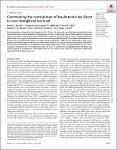Constraining the contribution of the Antarctic Ice Sheet to Last Interglacial sea-level
| dc.contributor.author | Barnett, R | |
| dc.contributor.author | Austermann, J | |
| dc.contributor.author | Dyer, B | |
| dc.contributor.author | Telfer, M | |
| dc.contributor.author | Barlow, N | |
| dc.contributor.author | Boulton, S | |
| dc.contributor.author | Carr, A | |
| dc.contributor.author | Creel, R | |
| dc.date.accessioned | 2023-07-07T09:07:25Z | |
| dc.date.issued | 2023-07-05 | |
| dc.identifier.issn | 2375-2548 | |
| dc.identifier.issn | 2375-2548 | |
| dc.identifier.other | ARTN eadf0198 | |
| dc.identifier.uri | https://pearl.plymouth.ac.uk/handle/10026.1/21028 | |
| dc.description.abstract |
Polar temperatures during the Last Interglacial [LIG; ~129 to 116 thousand years (ka)] were warmer than today, making this time period an important testing ground to better understand how ice sheets respond to warming. However, it remains debated how much and when the Antarctic and Greenland ice sheets changed during this period. Here, we present a combination of new and existing absolutely dated LIG sea-level observations from Britain, France, and Denmark. Because of glacial isostatic adjustment (GIA), the LIG Greenland ice melt contribution to sea-level change in this region is small, which allows us to constrain Antarctic ice change. We find that the Antarctic contribution to LIG global mean sea level peaked early in the interglacial (before 126 ka), with a maximum contribution of 5.7 m (50th percentile, 3.6 to 8.7 m central 68% probability) before declining. Our results support an asynchronous melt history over the LIG, with an early Antarctic contribution followed by later Greenland Ice Sheet mass loss. | |
| dc.format.extent | eadf0198- | |
| dc.format.medium | Print-Electronic | |
| dc.language | en | |
| dc.publisher | American Association for the Advancement of Science | |
| dc.subject | 37 Earth Sciences | |
| dc.subject | 3709 Physical Geography and Environmental Geoscience | |
| dc.subject | 3705 Geology | |
| dc.subject | 13 Climate Action | |
| dc.title | Constraining the contribution of the Antarctic Ice Sheet to Last Interglacial sea-level | |
| dc.type | journal-article | |
| dc.type | Article | |
| plymouth.author-url | https://www.ncbi.nlm.nih.gov/pubmed/37406130 | |
| plymouth.issue | 27 | |
| plymouth.volume | 9 | |
| plymouth.publication-status | Published | |
| plymouth.journal | Science Advances | |
| dc.identifier.doi | 10.1126/sciadv.adf0198 | |
| plymouth.organisational-group | |Plymouth | |
| plymouth.organisational-group | |Plymouth|Faculty of Science and Engineering | |
| plymouth.organisational-group | |Plymouth|Faculty of Science and Engineering|School of Geography, Earth and Environmental Sciences | |
| plymouth.organisational-group | |Plymouth|REF 2021 Researchers by UoA | |
| plymouth.organisational-group | |Plymouth|Users by role | |
| plymouth.organisational-group | |Plymouth|Users by role|Academics | |
| plymouth.organisational-group | |Plymouth|REF 2021 Researchers by UoA|UoA07 Earth Systems and Environmental Sciences | |
| plymouth.organisational-group | |Plymouth|REF 2021 Researchers by UoA|UoA14 Geography and Environmental Studies | |
| dc.publisher.place | United States | |
| dcterms.dateAccepted | 2023-06-05 | |
| dc.date.updated | 2023-07-07T09:07:24Z | |
| dc.rights.embargodate | 2023-7-7 | |
| dc.identifier.eissn | 2375-2548 | |
| rioxxterms.versionofrecord | 10.1126/sciadv.adf0198 |


